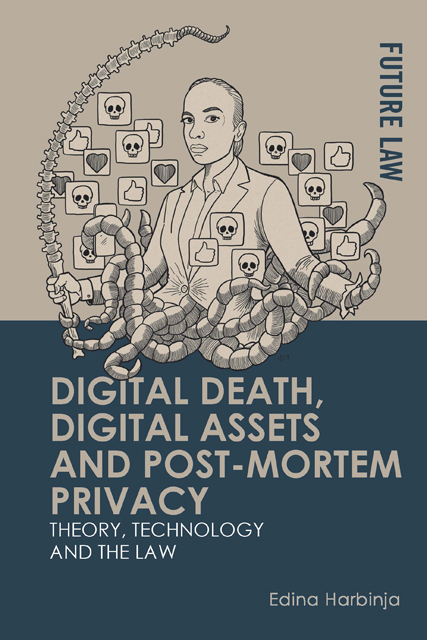Book contents
- Frontmatter
- Contents
- Acknowledgements
- Table of Cases
- Table of Legislation
- 1 Introduction
- 2 Theoretical Underpinnings: Property
- 3 Theoretical Underpinnings: Autonomy, Testamentary Freedom and Post-Mortem Privacy
- 4 Social Networks
- 5 Games, Virtual Worlds and Virtual Realities
- 6 Emails
- 7 Conclusion
- Bibliography
- Index
6 - Emails
Published online by Cambridge University Press: 25 April 2023
- Frontmatter
- Contents
- Acknowledgements
- Table of Cases
- Table of Legislation
- 1 Introduction
- 2 Theoretical Underpinnings: Property
- 3 Theoretical Underpinnings: Autonomy, Testamentary Freedom and Post-Mortem Privacy
- 4 Social Networks
- 5 Games, Virtual Worlds and Virtual Realities
- 6 Emails
- 7 Conclusion
- Bibliography
- Index
Summary
6.1 Conceptualisation and a Brief History of Emails
‘Electronic mail’ (email) is an electronic system for exchanging messages over the Internet. The common usage of the term ‘email’ refers to individual electronic messages, and usually only to the textual content of the messages and their attachments. This chapter will adopt this terminology and refer to email messages (hereinafter email) in terms of their content. Email accounts (hereinafter accounts) enable access to emails, and an analogy usually used here is that of letters. Along this line, accounts are some form of ‘physical’ representation of emails, enabling and regulating access to their content, just as paper is a physical representation of letters and their content, defining access to this content. This analogy will be used and evaluated in more detail later in this chapter.
The history of emails started in 1965 when Van Vleck of MIT invented ‘the first popular computer-based electronic mail service as a posting/delivery construct with addressing’. In the subsequent twenty years, many other system components (e.g. transfer protocol, content or user feature) were developed to create the system as it is nowadays. The technical features of the system are as follows: flexible form (plain text, right format, attachments, pictures, videos); asynchronous character (people send and receive messages on their own time); broadcast (the ability to send messages to many people simultaneously); push technology (the sender decides on the content and timing of a message); and threaded conversations.
Email still represents the core of all online communications, along with social networking. Usage of emails is relatively evenly spread across different age groups, making it the most used activity online in the UK and US. Today, communication is almost impossible to imagine without this quick, relatively reliable and convenient system used for various purposes, such as communication, task and contacts management, and sharing of documents, pictures, videos and other content as attachments, both for personal and business purposes. One could argue that social media and instant messaging will gradually supplant emails in online communications. However, research has found that similarly to emails complementing telephone and face-to-face communication, the use of social networks has complemented the use of emails so far, without resulting in a significant decrease in their use.
The consumer market is dominated by the email providers Google (Gmail), Microsoft (Outlook.com) and Yahoo! (Mail).
- Type
- Chapter
- Information
- Digital Death, Digital Assets and Post-Mortem PrivacyTheory, Technology and the Law, pp. 162 - 203Publisher: Edinburgh University PressPrint publication year: 2022

